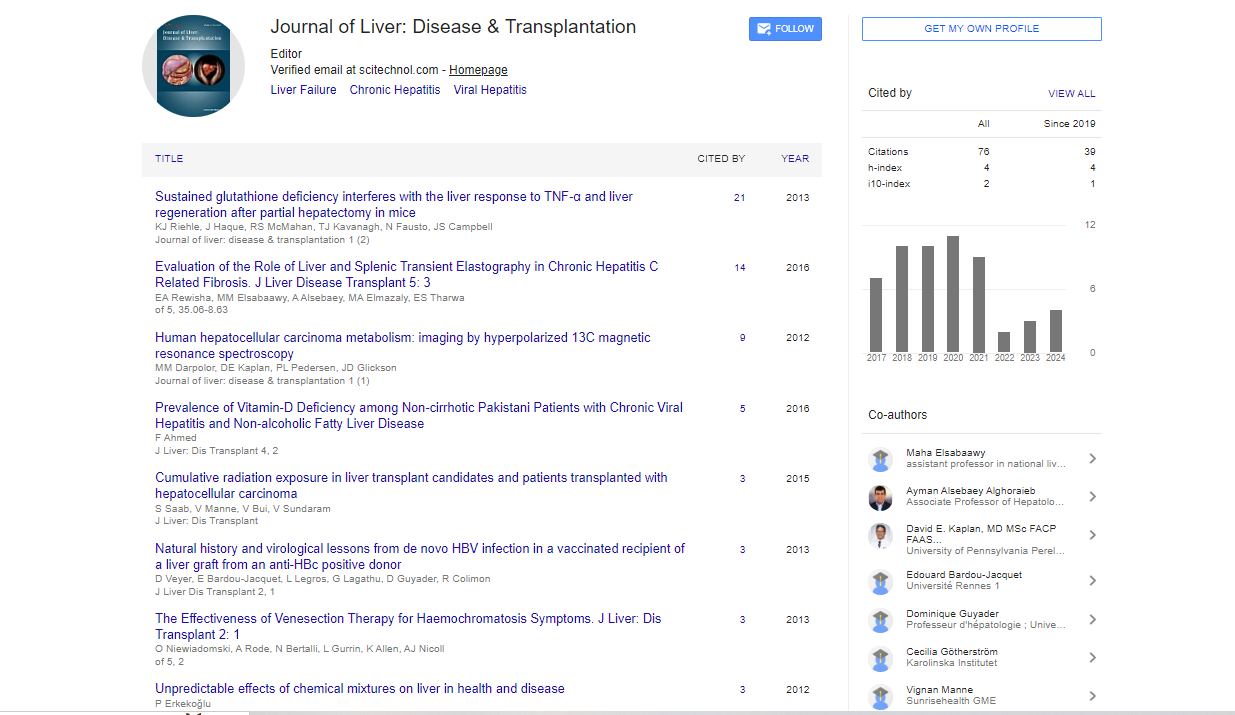Commentary, J Liver Disease Transplant Vol: 12 Issue: 4
In-Depth Analysis on Chronic Hepatitis: From Etiology to Prevention
Lu Kho*
1Department of General Surgery, Zhejiang University School of Medicine, Hangzhou, China
*Corresponding Author: Lu Kho,
Department of General Surgery, Zhejiang
University School of Medicine, Hangzhou, China
E-mail: lu.kho@zju.edu.cn
Received date: 20 November, 2023, Manuscript No. JLDT-23-123684;
Editor assigned date: 22 November, 2023, Pre QC No. JLDT-23-123684 (PQ);
Reviewed date: 06 December, 2023, QC No. JLDT-23-123684;
Revised date: 13 December, 2023, Manuscript No. JLDT-23-123684 (R);
Published date: 20 December, 2023, DOI: 10.36648/2325-9612.100251
Citation: Kho L (2023) In-Depth Analysis on Chronic Hepatitis: F rom Etiology to Prevention. J Liver Disease Transplant 12:4.
Abstract
Description
Chronic hepatitis is a formidable health challenge that silently affects millions worldwide, causing persistent inflammation of the liver. Unlike its acute counterpart, chronic hepatitis is often insidious, quietly advancing over years, potentially leading to severe complications such as cirrhosis, liver failure, and hepatocellular carcinoma. Chronic hepatitis is defined by the prolonged inflammation of the liver, lasting for at least six months. It is typically caused by viral infections, with Hepatitis B (HBV) and Hepatitis C (HCV) being the most common culprits. Other etiologies include autoimmune hepatitis, metabolic disorders, and prolonged exposure to certain drugs or toxins. Hepatitis B (HBV) is a DNA virus transmitted through blood and body fluids, including sexual contact and perinatal transmission.
Hepatitis C (HCV) an RNA virus primarily spread through blood contact, often associated with injection drug use and unsafe medical practices. Autoimmune Hepatitis is an an immune-mediated disorder where the body's immune system erroneously attacks the liver cells, leading to chronic inflammation. Metabolic conditions such as Nonalcoholic Fatty Liver Disease (NAFLD) and hemochromatosis can contribute to chronic hepatitis. Prolonged alcohol consumption, exposure to toxins, and certain medications can contribute to chronic liver inflammation.
Chronic hepatitis can manifest with a spectrum of symptoms, ranging from mild to severe. In many cases, patients may remain asymptomatic for an extended period, making early detection challenging. Common symptoms include fatigue, abdominal discomfort, jaundice, and unexplained weight loss. Progressive scarring of the liver tissue, disrupting its normal structure and function. Cirrhosis is a common consequence of untreated or inadequately managed chronic hepatitis. Advanced chronic hepatitis can lead to liver failure, a life-threatening condition requiring urgent medical intervention. Chronic hepatitis, especially with cirrhosis, significantly increases the risk of developing hepatocellular carcinoma, a primary liver cancer.
Diagnostic approaches
Liver function tests, viral hepatitis serology, and specific markers such as alpha-fetoprotein aid in the diagnosis and assessment of liver damage. Ultrasonography, Computed Tomography (CT), and Magnetic Resonance Imaging (MRI) help visualize the liver's structure and identify signs of cirrhosis or tumors. A tissue sample is obtained for microscopic examination, providing detailed information about the extent of liver inflammation and fibrosis. Advanced imaging techniques and blood tests offer non-invasive alternatives to liver biopsy for assessing fibrosis. For viral hepatitis, antiviral medications are employed to suppress viral replication and reduce liver inflammation.
In the case of HBV, nucleoside or nucleotide analogs are often prescribed, while Direct-Acting Antivirals (DAAs) are the mainstay for HCV. Autoimmune hepatitis may require immunosuppressive drugs such as corticosteroids or azathioprine to modulate the immune response and reduce inflammation. Alcohol cessation, weight management, and the avoidance of hepatotoxic substances are integral components of managing chronic hepatitis. Regular follow-up visits, blood tests, and imaging studies are crucial to monitor treatment response, detect complications early, and adjust therapeutic approaches as needed.
Chronic hepatitis poses significant public health challenges globally. Factors such as inadequate awareness, limited access to healthcare, and the asymptomatic nature of the disease contribute to its silent progression. Efforts to enhance public awareness, implement vaccination programs, and improve access to screening and treatment are vital for mitigating the impact of chronic hepatitis on population health. A highly effective vaccine is available for hepatitis B, offering protection against infection and preventing the development of chronic hepatitis. Timely screening of high-risk populations, such as individuals with a history of intravenous drug use or unprotected sexual activity, allows for early detection and intervention.
Conclusion
In conclusion, chronic hepatitis is a complex and multifaceted condition with far-reaching consequences for individual health and public well-being. The silent progression of the disease emphasizes the importance of proactive screening, early diagnosis, and comprehensive management. As study continues to unravel the intricacies of chronic hepatitis, the integration of preventive measures, vaccination programs, and accessible healthcare will be pivotal in the global effort to curb the impact of this silent menace on the liver and public health.
 Spanish
Spanish  Chinese
Chinese  Russian
Russian  German
German  French
French  Japanese
Japanese  Portuguese
Portuguese  Hindi
Hindi 